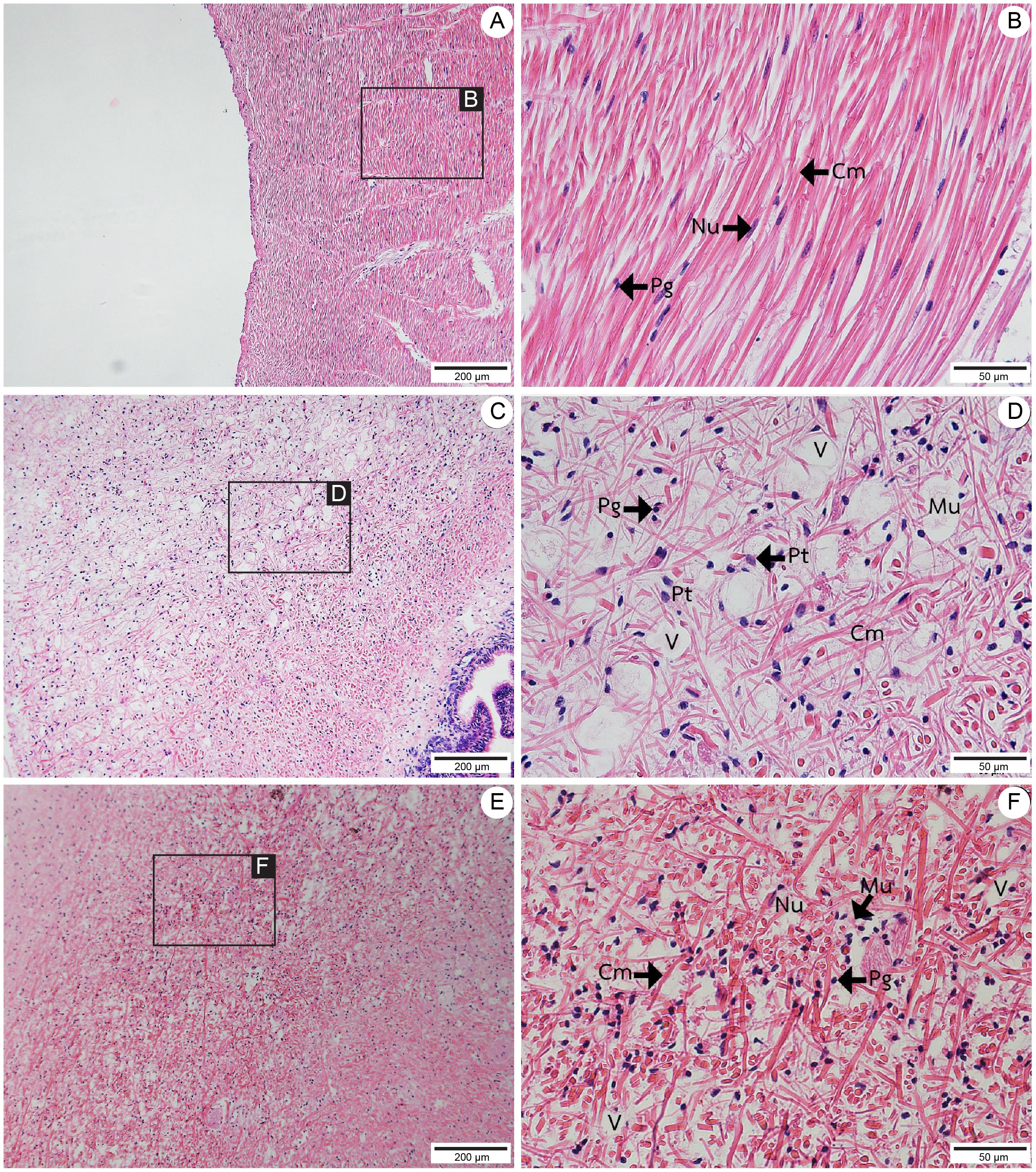การเปลี่ยนแปลงของเนื้อเยื่อทางจุลพยาธิวิทยาในหอย Tarebia granifera (Lamarck, 1822) จากพื้นที่ปนเปื้อนโลหะหนัก (แคดเมียม) ที่ห้วยแม่ตาว จังหวัดตาก
Main Article Content
Abstract
Sombat Singhakaew, Pinida Joradon, Ekgachai Jeratthitikul, Sirikanya Thanyakorn and Prayad Pokethitiyook
รับบทความ: 12 กุมภาพันธ์ 2564; แก้ไขบทความ: 20 กรกฎาคม 2565; ยอมรับตีพิมพ์: 27 สิงหาคม 2565; ตีพิมพ์ออนไลน์: 11 พฤศจิกายน 2565
บทคัดย่อ
ห้วยแม่ตาวเป็นลำน้ำขนาดเล็กที่เป็นสาขาของแม่น้ำเมย อยู่ในอำเภอแม่สอด จังหวัดตาก ของประเทศไทย ซึ่งพบการปนเปื้อนโลหะหนักแคดเมียมในแหล่งน้ำปริมาณสูงซึ่งเป็นผลพวงจากการทำเหมืองแร่สังกะสีในพื้นที่ต้นน้ำ การปนเปื้อนแคดเมียมในแหล่งน้ำผิวดินสูงเกินค่ามาตรฐานส่งผลกระทบต่อสัตว์น้ำ งานวิจัยนี้มีวัตถุประสงค์เพื่อศึกษาการเปลี่ยนแปลงทางจุลพยาธิวิทยาของเนื้อเยื่อในหอยเจดีย์ปุ่มยอดแหลม (Tarebia granifera Lamarck, 1822) ซึ่งเป็นสัตว์น้ำที่พบได้ทั่วไปในห้วยแม่ตาวและแม่น้ำเมย ในการศึกษานี้ได้เก็บตัวอย่างหอยจากพื้นที่ปนเปื้อนแคดเมียมและนำมาผ่านกระบวนการทางเนื้อเยื่อเพื่อศึกษาการเปลี่ยนแปลงที่เกิดขึ้นในเนื้อเยื่อจากอวัยวะต่าง ๆ โดยที่ตัวอย่างหอยที่เก็บจากแม่น้ำเมยถูกใช้เป็นกลุ่มอ้างอิง ผลการศึกษาแสดงให้เห็นว่าหอยตัวอย่างที่อาศัยอยู่ในพื้นที่ปนเปื้อนแคดเมียมมีการเปลี่ยนแปลงของเนื้อเยื่อในอวัยวะต่าง ๆ เช่น เส้นใยกล้ามเนื้อในเนื้อเยื่อแผ่นเท้าผิดปกติ การลดจำนวนของซีเลียที่บริเวณซี่เหงือก เซลล์เยื่อบุลำไส้รูปร่างผิดปกติและการขยายออกของท่อภายในต่อมย่อยอาหาร การศึกษาการเปลี่ยนแปลงของเนื้อเยื่อทางจุลพยาธิวิทยาของหอยเจดีย์ปุ่มยอดแหลมมีแนวโน้มสัมพันธ์กับพื้นที่ปนเปื้อนแคดเมียมและสามารถใช้เป็นตัวบ่งชี้ทางชีวภาพในแหล่งน้ำที่มีการปนเปื้อนแคดเมียมได้
คำสำคัญ: ห้วยแม่ตาว แม่น้ำเมย แคดเมียม หอยเจดีย์ปุ่มยอดแหลม (Tarebia granifera) ตัวบ่งชี้ทางชีวภาพ
Abstract
Huai Mae Tao is a small creek tributary of Moei River, located in Mae Sot District, Tak Province, Thailand. It was found that the creek has been contaminated with cadmium (Cd) caused by the zinc mine activity in the upstream area. The Cd was exceeded the maximum allowable concentration in surface water sources that could effect on aquatic animals in this area. The aim of this research was to study the histopathological changes in tissue of the gastropod, Tarebia granifera (Lamarck, 1822), which is the most abundant aquatic mollusk found in Huai Mae Tao and Moei River. The snails were randomly collected from the Cd contaminated area. Then, they were histologically processed for investigating the histological changes in their tissue in the laboratory. The snails collected from Moei River were served as a reference group. The results revealed that T. granifera in contaminated area had abnormally changed in tissues of various organs such as abnormal muscle fibers in foot tissue, reduction of the number of gill cilia, irregular shaped epithelial cells in intestine, and dilation of digestive gland tubules. From the histological results of this study, T. granifera might be used as a bioindicator for Cd contaminated surface water resource.
Keywords:Huai Mae Tao, Moei River, Cadmium, Tarebiagranifera, bioindicator
Downloads
Article Details

This work is licensed under a Creative Commons Attribution-NonCommercial 4.0 International License.
References
Appleton, C. C., Forbes, A. T., and Demetriades, N. T. (2009). The occurrence, bionomics and potential impacts of the invasive freshwater snail Tarebia granifera (Lamarck, 1822) (Gastropoda: Thiaridae) in South Africa. Zoology Medicine 83(4): 525–536.
Araujo, R., Remon, J. M., Moreno, D., and Ramos, M. A. (1995). Relaxing techniques of freshwater molluscs: Trials for evaluation of different methods. Malacologia 36(12): 29–41.
Aukkanimart, R., Boonmars, T., Pinlaor, S., Tesana, S., Aunpromma, S., Booyarat, C., and Punjaruk, W. (2013). Histopathological changes in tissues of Bithynia siamensis goniomphalos incubated in crude extracts of camellia seed and mangosteen pericarp. Korean Journal of Parasitology 51(5): 537–544.
Bancroft, J. D., and Gamble, M. (2007). Theory and Practice of Histological Techniques. 7th ed. London, UK: Chuchill Livingstone.
Brandt, R. A. M. (1974). The non–marine aquatic Mollusca of Thailand. Archiv für Molluskenkunde. 105: 1–423.
Caroline, D. H., and Diane, J. (2014). The effect of sedimentation levels on Tarebia granifera in freshwater lagoons in Punta Cana, Dominican Republic. The Journal of Sustainable Development 11(1): 132–152.
Dummee, V. (2012). Accumulation and Toxicity of Sediments from Beung Boraphet in Pomacea canaliculata Light and Electron Microscope. Doctoral Dissertation. Bangkok: Mahidol University. (in Thai)
Dummee, V., Tanhan, P., Kruatrachue, M., Damrongphol, P., and Pokethitiyook, P. (2015). Histopathological changes in snail, Pomacea canaliculata, exposed to sub–lethal copper sulfate concentrations. Ecotoxicology and Environmental Safety 122: 290–295.
Erhan, U., Elif, I. C., Mehmet, Z. Y., Birgul O., and Ozkan U. (2005). Histopathological effects in tissues of snail Lymnaea stagnalis (Gastropod, Pulmonata) exposed to sublethal concentration of Thiodan and recovery after exposure. Journal of Applied Toxicology. 25: 459–463.
Federation, W. E., and APH Association. (2005). Standard methods for the examination of water and wastewater. American Public Health Association (APHA). Washington, DC, USA.
Jantataeme, S., Kruatrachue, M., Kaewsawangup., S., Chitramwong, Y., Sretarugsa, P., and Upathum, E. S. (1996). Acute toxicity and bioaccumulation of lead in the snail, Filopaludina m. martenis. Journal of science Asia Thailand 22: 237–247.
Kaewsawangsup, S. (1996). Acute Toxicity Bioaccumulation and Effects of Lead on the Histology of Snails, Filopaludina (Siamopalldina) M. Martensi (Frauenfeldt). Master Thesis in Science. Bangkok: Mahidol University. (in Thai)
Karakaş, S. B., and Otludil, B., (2020). Accumulation and histopathological effects of cadmium on the great pond snail Lymnaea stagnalis Linnaeus, 1758 (Gastropoda: Pulmonata). Environmental Toxicology and Pharmacology 78: Article 103 403.
Mooltongnoi, C., and Alunlertarele, J. (2008). Water quality and contamination of heavy metal in surface water of Huai Mae Tao, Tak Province. Environment and Natural Resources Journal 6(2): 103–112. (in Thai)
Neeratanaphan, L. (2011). Effects of heavy metals on mollusk. KKU Science Journal 39: 375–386. (in Thai)
Songprasert, N., Sukaew, T., Kusreesakul, K., Swaddiwudhipong, W., Padungtod, C., and Bundhamcharoen, K. (2015). Additional burden of diseases associated with cadmium exposure: A case study of cadmium contaminated rice fields in Mae Sot District, Tak Province, Thailand. International Journal of Environmental Research and Public Health 12(8): 9199–9217.
Thamjedsada, T., and Chaiwiwatworakul, P. (2012). Evaluation of cadmium contamination in the Mae Tao Creek sediment. International Conference on Sustainable Environmental Technologies (ICSET) (pp. 501–511). Bangkok, Thailand.
Weeraprapan, P., Phalaraksh, C., Chantara, S., and Kawashima, M. (2015). Water quality monitoring and cadmium contamination in the sediments of Mae Tao Stream, Mae Sot District, Tak Province, Thailand. International Journal of Environmental Science and Development 6(2): 142–146.
